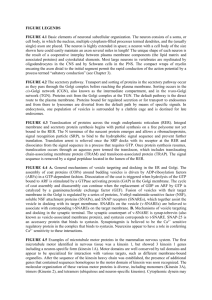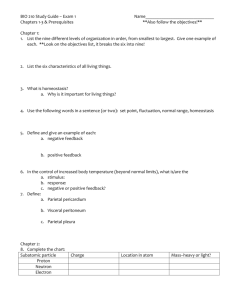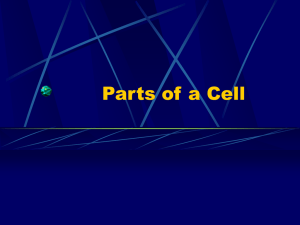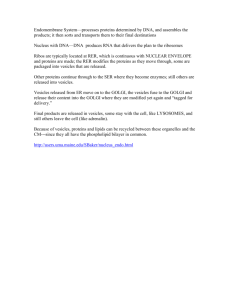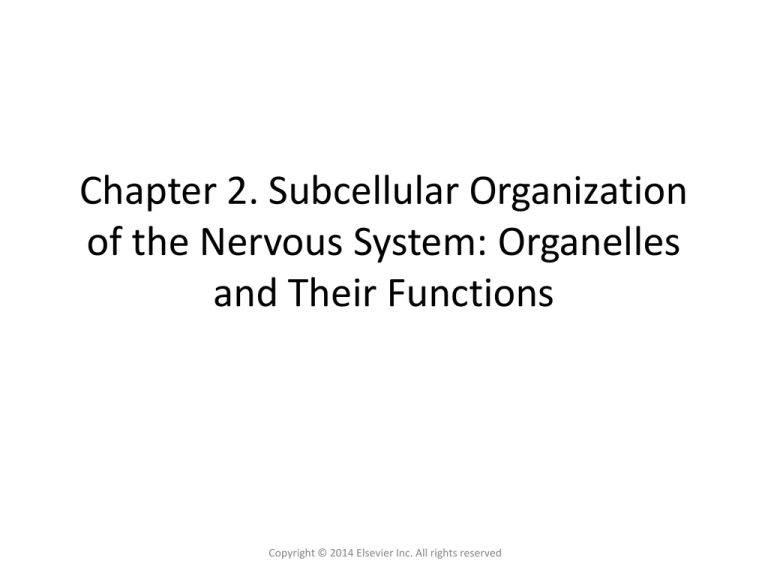
Chapter 2. Subcellular Organization
of the Nervous System: Organelles
and Their Functions
Copyright © 2014 Elsevier Inc. All rights reserved
Figure 2.1 The “Nissl body”
in neurons is an array of cytoplasmic-free polysomal rosettes (boxed) interspersed between rows of rough endoplasmic reticulum
(RER) studded with membrane-bound ribosomes. Nascent polypeptide chains emerging from the ribosomal tunnel on the RER
are inserted into the lumen (arrow), where they may be processed before transport out of the RER. The relationship between the
polypeptide products of these “free” and “bound” polysome populations in the Nissl body, an arrangement that is unique to
neurons, is unknown.
Copyright © 2014 Elsevier Inc. All rights reserved
Figure 2.2 Basic elements of neuronal subcellular organization.
The neuron consists of a soma, or cell body, in which the nucleus, multiple cytoplasm-filled processes termed dendrites, and the
(usually single) axon are placed. The neuron is highly extended in space; one with a cell body of the size shown here might
maintain an axon several miles in length! The unique shape of each neuron is the result of a cooperative interplay between
plasma membrane components and cytoskeletal elements. Most large neurons in vertebrates are myelinated by
oligodendrocytes in the CNS and by Schwann cells in the PNS. The compact wraps of myelin encasing the axon distal to the
initial segment permit rapid conduction of the action potential by a process termed saltatory conduction (see Chapter 4).
Copyright © 2014 Elsevier Inc. All rights reserved
Figure 2.3 The secretory pathway.
Transport and sorting of proteins in the secretory pathway occur as they pass through the Golgi before reaching the
plasma membrane. Sorting occurs in the cis-Golgi network (CGN), also known as the intermediate compartment, and in
the trans-Golgi network (TGN). Proteins exit from the Golgi at the TGN. The default pathway is the direct route to the
plasma membrane. Proteins bound for regulated secretion or transport to endosomes are diverted from the default path
by means of specific signals. In endocytosis, one population of vesicles is surrounded by a clathrin cage and is destined for
late endosomes.
Copyright © 2014 Elsevier Inc. All rights reserved
Figure 2.4 Translocation of proteins across the rough endoplasmic reticulum (RER).
Integral membrane and secretory protein synthesis begins with partial synthesis on a free polysome not yet bound to the RER.
The N-terminus of the nascent protein emerges and allows a ribonucleoprotein, signal recognition particle (SRP), to bind to the
hydrophobic signal sequence and prevent further translation. Translation arrest is relieved once the SRP docks with its receptor
at the RER and dissociates from the signal sequence in a GTP-dependent process. Once protein synthesis resumes, translocation
occurs through an aqueous pore termed the translocon, which includes the translocating chain associating membrane protein
(TRAM). The signal sequence is removed by a signal peptidase in the RER lumen.
Copyright © 2014 Elsevier Inc. All rights reserved
Figure 2.5 A. General mechanisms of vesicle targeting and docking in the ER and Golgi. Assembly of coat proteins (COPs) around budding vesicles is
driven by ADP-ribosylation factors (ARFs) in a GTP-dependent fashion. Dissociation of the coat is triggered by hydrolysis of GTP bound to ARF and is
stimulated by a GTPase-activating protein (GAP) in the Golgi membrane. The cycle of coat assembly and disassembly can continue when
replacement of GDP on ARF by GTP is catalyzed by a guanine nucleotide exchange factor (GEF). Fusion of vesicles with target membrane in the
Golgi is regulated by a series of proteins, N-ethyl-maleimide-sensitive factor (NSF), soluble NSF attachment proteins (SNAPs), and SNAP receptors
(SNAREs), which together assist vesicle docking with target membrane. SNAREs on vesicles (v-SNAREs) are believed to associate with
corresponding t-SNAREs on target membrane. B. Mechanisms of vesicle targeting and docking in the synaptic terminal. The synaptic counterpart of
v-SNARE is synaptobrevin (also known as VAMP), and syntaxin corresponds to t-SNARE. SNAP-25 is an accessory protein that binds to syntaxin.
Synaptotagmin is believed to be the Ca2+ sensitive regulatory protein in the complex that binds to syntaxin. Neurexins appear to have a role in
conferring Ca2+ sensitivity to these interactions.
Copyright © 2014 Elsevier Inc. All rights reserved
Figure 2.6 Examples of microtubule motor proteins in the mammalian nervous system.
The first microtubule motor identified in nervous tissue was a kinesin 1, but studies in mammalian genomes identified 3 kinesin 1
genes, including a neuron-specific form (kinesin 1A). Motor domains are well conserved in all kinesin superfamily genes, but tail
domains are more variable and only show homology within a given gene family (e.g., Kinesin 1A, 1B and 1C). Tail domains appear to be
specialized for interaction with various target cargos, such as different membrane-bound organelles. After the sequence of the kinesin
heavy chain was established, the presence of additional genes that contained sequences homologous to the motor domain of kinesin
was soon recognized. The molecular organization of these various motor proteins is diverse, including monomers (Kinesin 3A), trimers
(Kinesin 2), and tetramers (ubiquitous and neuron-specific kinesins). Cytoplasmic dynein may interact with membrane-bound
organelles (MBO) and cytoskeletal structures, such as microtubules. Genetic methods have established that there may be >45 kinesinrelated genes and 16 dynein heavy chains genes in a single organism.
Copyright © 2014 Elsevier Inc. All rights reserved
Figure 2.7 Examples of myosin motor proteins found in mammalian brain.
Myosin heavy chains contain the motor domain, whereas light chains (small dumbbell-shaped structures) regulate motor function.
Myosin II was the first molecular motor characterized biochemically from skeletal muscle and brain. Genetic approaches have now
defined >15 classes of myosin, many of which are found in brain. Myosin II is a classic two-headed myosin forming thick filaments in
nonmuscle cells. Myosin I motors have single motor domains, but may interact with actin microfilaments or membranes. Myosin V has
multiple binding sites for calmodulin (dumbbell-shaped structures) that act as light chains bound to the motor domain. Mutations in
other classes of myosin have been linked to deafness. Myosins I, II, and V have been detected in growth cones as well as in mature
neurons.
Copyright © 2014 Elsevier Inc. All rights reserved
Figure 2.8 Slow axonal transport represents the delivery of cytoskeletal and cytoplasmic constituents to the periphery.
Cytoplasmic proteins are synthesized on free polysomes and organized for transport as cytoskeletal elements or macromolecular
complexes (1). Microtubules are formed by nucleation at the microtubule-organizing center near the centriolar complex (2) and then
released for migration into axons or dendrites. Slow transport appears to be unidirectional with no net retrograde component. Studies
suggest that cytoplasmic dynein may move microtubules with their plus ends leading (3). Neurofilaments may move on their own or
may hitchhike on microtubules (4). Once cytoplasmic structures reach their destinations, they are degraded by local proteases (5) at a
rate that allows either growth (in the case of growth cones) or maintenance of steady-state levels. The different composition and
organization of cytoplasmic elements in dendrites suggest that different pathways may be involved in delivery of cytoskeletal and
cytoplasmic materials to dendrites (6). In addition, some mRNAs are transported into dendrites, but not into axons.
Copyright © 2014 Elsevier Inc. All rights reserved
Figure 2.9 Fast axonal transport represents transport of membrane-associated materials, having both anterograde and retrograde components.
For anterograde transport, most polypeptides are synthesized on membrane-bound polysomes, also known as rough endoplasmic reticulum (1), and
then transferred to the Golgi for processing and packaging into specific classes of membrane-bound organelles (2). Proteins following this pathway
include both integral membrane proteins and secretory polypeptides in the vesicle lumen. Cytoplasmic peripheral membrane proteins such as
kinesins are synthesized on free polysomes. Once vesicles are assembled and appropriate motors associate with them, they move down the axon at a
rate of 100–400 mm per day (3). Different membrane structures are delivered to different compartments and may be regulated independently. For
example, dense core vesicles and synaptic vesicles are both targeted for presynaptic terminals (4), but release of vesicle contents involves distinct
pathways. After vesicles merge with the plasma membrane, their protein constituents are taken up in coated vesicles via the receptor-mediated
endocytic pathway and delivered to a sorting compartment (5). After proper sorting into appropriate compartments, membrane proteins are either
committed to retrograde axonal transport or recycled (6). Retrograde moving organelles are morphologically and biochemically distinct from
anterograde vesicles. These larger vesicles have an average velocity about half that of anterograde transport. The retrograde pathway is an important
mechanism for delivery of neurotrophic factors to the cell body. Material delivered by retrograde transport typically fuses with cell body
compartments to form mature lysosomes (7), where constituents are recycled or degraded. However, neurotrophic factors and neurotrophic viruses
act at the level of the cell body and escape this pathway. Vesicle transport also occurs into dendrites (8), but less is known about this process.
Copyright © 2014 Elsevier Inc. All rights reserved
Figure 2.10 Axonal dynamics in a myelinated axon from the peripheral nervous system (PNS).
Axons are in a constant flux with many concurrent dynamic processes. This diagram illustrates a few of the many dynamic events occurring at a node of
Ranvier in a myelinated axon from the PNS. Axonal transport moves cytoskeletal structures, cytoplasmic proteins, and membrane-bound organelles from the
cell body toward the periphery (from right to left). At the same time, other vesicles return to the cell body by retrograde transport (retrograde vesicle).
Membrane-bound organelles are moved along microtubules by motor proteins such as the kinesins and cytoplasmic dyneins. Each class of organelles must be
directed to the correct functional domain of the neuron. Synaptic vesicles must be delivered to a presynaptic terminal to maintain synaptic transmission. In
contrast, organelles containing sodium channels must be targeted specifically to nodes of Ranvier for saltatory conduction to occur. Cytoskeletal transport is
illustrated by microtubules (rods in the upper half of the axon) and neurofilaments (bundle of rope-like rods in the lower half of the axon) representing the
cytoskeleton. They move in the anterograde direction as discrete elements and are degraded in the distal regions. Microtubules and neurofilaments interact
with each other transiently during transport, but their distribution in axonal cross sections suggests that they are not stably cross-linked. In axonal segments
without compact myelin, such as the node of Ranvier or following focal demyelination, a net dephosphorylation of neurofilament side arms allows the
neurofilaments to pack more densely. Myelination is thought to alter the balance between kinase (K indicates an active kinase; k is an inactive kinase) and
phosphatase (P indicates an active phosphatase; p is an inactive phosphatase) activity in the axon. Most kinases and phosphatases have multiple substrates,
suggesting a mechanism for targeting vesicle proteins to specific axonal domains. Local changes in the phosphoryation of axonal proteins may alter the binding
properties of proteins. The action of synapsin I in squid axoplasm suggests that dephosphorylated synapsin cross-links synaptic vesicles to microfilaments.
When a synaptic vesicle encounters the dephosphorylated synapsin and actin-rich matrix of a presynaptic terminal, the vesicle is trapped at the terminal by
inhibition of further axonal transport, effectively targeting the synaptic vesicle to a presynaptic terminal. Similarly, a sodium channel-binding protein may be
present at nodes of Ranvier in a high-affinity state (i.e., dephosphorylated). Transport vesicles for nodal sodium channels (Na channel vesicle) would be
captured upon encountering this domain, effectively targeting sodium channels to the nodal membrane. Interactions between cells could in this manner
establish the functional architecture of the neuron.
Copyright © 2014 Elsevier Inc. All rights reserved


